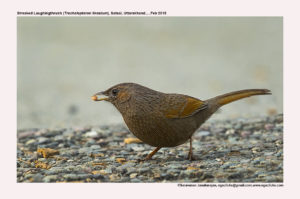Streaked Laughingthrush

Streaked Laughingthrush Garrulax lineatus
Etymology:
- Garrulax : Latin word garrulous –babbling, chattering; ax – inclining towards
- Lineatus : Latin word marked with lines
Vernacular Names: Kash: Sheen-pi-pi, Nepal: Bhekura
Distribution in India: Resident of Himalayas in India.
Description: Size of 18-20 cm. It is a small laughingthrush, streaky-brown and grey with dull rufous ear-coverts. The nominate race has streaked dull rufous-brown and grey crown, neck side and mantle, shifting on scapulars and back to dull rufous-brown with sparse long whitish shaft streaks, rump dull pale olive-grey. The upperwing and tail are rufescent pale grey-brown, former with strong rufescent wingpanel, latter with dark-bordered dirty greyish tips. The ear-coverts are dull rufous, the face, lores, supercilium, cheek and submoustachial area are streaked dull rufous and grey. Thechin to lower underparts issimilar with narrow buff shaft streaks. The flanks, thighs and vent are dark ochrous olive-brown. The iris is reddish-brown to brown; bill is dark brown and paler below; legs flesh-brown or pale horn-brown. Both the sexes are similar. The juvenile is warmer and less distinctly streaked than adult, crown has vague dark striations, mantle and breast with thin pale shaft streaks. The nominate is found in Uttarakhand ; race setafer( Sikkim to North Bengal) is like nominate but centers of streaks on crown and mantle blacker, posterior upperparts darker olive, base colour of underparts warmer and browner, and broader blackish subterminal tailband
Habitat: It is found in bushes and scrub, shrubbery in open forest, at forest edge, and around human habitation, field borders, gardens, thick scrub and stone walls near cultivation. Found at 1400–3905 m.
Food habits : It eats Insects, including moths and caterpillars, small flies, and ants, also spiders and berries, fruits and seeds. Found in pairs or in small parties of 3–6 individuals, depending on season. It keeps to the ground and feeds in open, as well as under bushes.
Breeding habits: They breed in Mar–Oct in India. The nest is reportedly an outwardly loose, untidy, thick-walled, deep cup , made of coarse dry grasses, fine plant stems, dead leaves, fibrous plant bark, creepers, dry twigs, ferns and moss, lined with fine grass roots, fine grasses, rootlets, pine needles and hair, placed in thick bush, on low tree branch, thick grass or on bank among overhanging grass. They lay a clutch of 2–4 eggs. The incubation is done by both sexes. The nest is parasitized by Jacobin Cuckoo, Large Hawk-cuckoo and Indian Cuckoo.